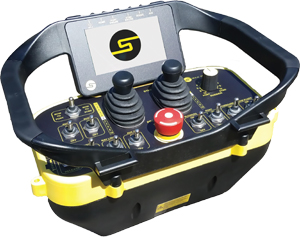A wireless helm developed by Sea Machines has received approval for use on a class of U.S.-flag tugboats that support articulated tug-barge (ATB) sets, a new way of doing business that is bound to generate comment among mariners.
The SM200 system frees the primary operator of a vessel from remaining at or near a fixed control position (e.g., the bridge or pilothouse). Through a wireless connection, the individual can control steering and propulsion as well as auxiliary equipment including pumps, winches and anchor windlasses.
According to the company, the specific advantage for ATB operations comes in the tricky process of connecting the tug in the barge notch. The operator can retain full control of the tug while overseeing placement of the connecting pins from outside the wheelhouse.
While touted as a groundbreaking development for operations on the water, similar technologies began to be deployed in some railway operations in the 1980s. By the early 2000s, nearly all major North American railroads had adopted belt-mounted operator control panels to allow yard personnel, not engineers, to conduct low-speed switching and shunting operations to make up freight trains. Although initially there were doubters, the systems have become part of standard operating procedures.
Sea Machines announced approval in early January of the SM200 by the U.S. Coast Guard and American Bureau of Shipping. The company declined to provide details of the process, as did public affairs contacts at both the Coast Guard and ABS.
The Boston-based developer of autonomous marine systems said approval was granted “after an exhaustive review of Sea Machines’ technology and the SM200’s applications aboard these tugs, deeming the system satisfactory for shipboard installation and trials.” The company said it managed the review process in partnership with its dealer, Rio Controls & Hydraulics of Houston.
“This approval will unquestionably be the first of many to come for a wide variety of vessel types and is already fostering greater industry acceptance for this new realm of marine technology that boosts the capability, productivity and safety of vessel operations,” said Michael Johnson, Sea Machines’ chief executive officer.
The SM200 is commercially available and can be installed on any workboat or mid-size spill response vessel, company spokeswoman Amelia Smith told Professional Mariner. “It just so happened that we got approved for articulated tug-barges first,” she said.
Regulatory approval of the SM200 for ATB tugs was important due to the visibility challenges on the vessels and the need to prevent spills, Smith said. The signal range for the system is more than a half-mile, but someone must still be on board at all times.
“We look at this as supervised autonomy,” she said. “We believe the big takeaway is that this introduces flexibility — you aren’t locked into the wheelhouse.”
Smith said the system is designed to be intuitive, but Sea Machines also will provide training.
She said ABS conducted an exhaustive review of the technology from every possible angle, understanding that the vessel would still be manned. The bureau approved the system because it believed it would be good for the industry, she added.
“We can’t reveal exactly how we secure our systems from hacking,” Smith said. “I can assure you that we have protection in place, but discussing the methods could expose us and make the system vulnerable.”

